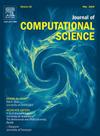Bearing-distance flocking with zone-based interactions in constrained dynamic environments
IF 3.7
3区 计算机科学
Q2 COMPUTER SCIENCE, INTERDISCIPLINARY APPLICATIONS
引用次数: 0
Abstract
This paper presents a novel zone-based flocking control approach suitable for dynamic multi-agent systems (MAS). Inspired by Reynolds behavioral rules for boids, flocking behavioral rules with the zones of repulsion, conflict, attraction, and surveillance are introduced. For each agent, using only bearing and distance measurements, behavioral contribution vectors quantify the local separation, local and global flock velocity alignment, local cohesion, obstacle avoidance and boundary conditions, and strategic separation for avoiding alien agents. The control strategy uses the local perception-based behavioral contribution vectors to guide each agent’s motion. Additionally, the control strategy incorporates a directionally aware obstacle avoidance mechanism that prioritizes obstacles in the agent’s forward path. Simulation results validate the effectiveness of the model in creating flexible, adaptable, and scalable flocking behavior. Asymptotic stability and convergence to a stable flocking configuration for any initial conditions provided the interaction graph is a spanning tree are demonstrated. The flocking model’s reliance on locally sensed bearing and distance measurements ensures scalability and robustness, particularly in scenarios where communication is unreliable or resource-intensive. This makes it well-suited for real-world applications demanding seamless operation in highly dynamic and distributed environments.
约束动态环境下基于区域交互的方位距离蜂群
提出了一种适用于动态多智能体系统(MAS)的基于区域的群集控制方法。受雷诺兹生物行为规则的启发,引入了排斥、冲突、吸引和监视区域的群集行为规则。对于每个智能体,仅使用方位和距离测量,行为贡献向量量化了局部分离,局部和全局群速对齐,局部内聚,避障和边界条件,以及避免外来智能体的策略分离。该控制策略使用基于局部感知的行为贡献向量来引导每个智能体的运动。此外,该控制策略还结合了一个方向感知的避障机制,该机制可以优先考虑智能体前进路径上的障碍物。仿真结果验证了该模型在创建灵活、适应性强、可扩展的群集行为方面的有效性。证明了在任意初始条件下,当相互作用图是生成树时,趋近稳定和收敛于稳定的群集构型。群集模型依赖于本地感知的方位和距离测量,确保了可扩展性和鲁棒性,特别是在通信不可靠或资源密集的情况下。这使得它非常适合在高度动态和分布式环境中要求无缝操作的实际应用程序。
本文章由计算机程序翻译,如有差异,请以英文原文为准。
求助全文
约1分钟内获得全文
求助全文
来源期刊

Journal of Computational Science
COMPUTER SCIENCE, INTERDISCIPLINARY APPLICATIONS-COMPUTER SCIENCE, THEORY & METHODS
CiteScore
5.50
自引率
3.00%
发文量
227
审稿时长
41 days
期刊介绍:
Computational Science is a rapidly growing multi- and interdisciplinary field that uses advanced computing and data analysis to understand and solve complex problems. It has reached a level of predictive capability that now firmly complements the traditional pillars of experimentation and theory.
The recent advances in experimental techniques such as detectors, on-line sensor networks and high-resolution imaging techniques, have opened up new windows into physical and biological processes at many levels of detail. The resulting data explosion allows for detailed data driven modeling and simulation.
This new discipline in science combines computational thinking, modern computational methods, devices and collateral technologies to address problems far beyond the scope of traditional numerical methods.
Computational science typically unifies three distinct elements:
• Modeling, Algorithms and Simulations (e.g. numerical and non-numerical, discrete and continuous);
• Software developed to solve science (e.g., biological, physical, and social), engineering, medicine, and humanities problems;
• Computer and information science that develops and optimizes the advanced system hardware, software, networking, and data management components (e.g. problem solving environments).
 求助内容:
求助内容: 应助结果提醒方式:
应助结果提醒方式:


